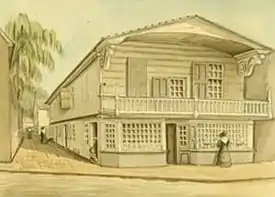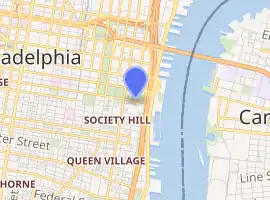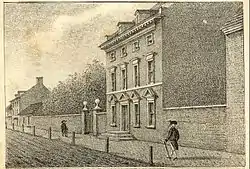Benjamin Loxley house
The Benjamin Loxley house was a house in Philadelphia, Pennsylvania owned by a major of the same name who served in the Continental Army. The house is noted in history as the place where Lydia Darragh, a Quaker Patriot, overheard secret British plans and passed them on the next day to General George Washington. Her efforts are believed to have saved the Continental Army from a surprise attack on December 4, 1777 from British General William Howe, who was occupying Philadelphia.
| Benjamin Loxley house | |
|---|---|
 Benjamin Loxley house (1828), watercolor 177 South Second Street, Old Philadelphia | |

| |
| General information | |
| Type | House |
| Construction started | 1760 |
| Technical details | |
| Structural system | Wood |
| Floor count | 2 |
The house is also noteworthy because of its unique architectural design. It had a covered balcony on its second story, which represented prestige and wealth. From here the renowned English evangelist George Whitefield preached to large crowds in religious revivals. The structure was located in an upscale neighborhood of wealthy citizens and high-ranking military officers. Nearby was a famous spa that was well known for its high quality natural spring water.
Description
Benjamin Loxley constructed the wood frame house around 1760 as an investment and income property.[1] It was on the east side of Second street, at the southeast corner of Little Dock street in downtown Philadelphia about two blocks west of the Delaware River.[2] The house was a two-story structure with a balcony across the entire front on the second story that projected out over the low first story. The first story had two large windows with small panes of glass. The inverted "V" peaked roof projected out over the balcony, partly protecting it against the weather. The roof was supported by protruding bulky carved ornamental cantilever supports. The balcony represented prestige and wealth. It was one of the places from where English evangelist George Whitefield preached to large crowds in the Great Awakening religious revivals he did during his American tours.[1][3][4] Historians record that he occupied the house and preached off the balcony to thousands in 1769.[2][5][6]
Loxley also owned the property behind the house, which he acquired from George Clymere in April, 1759.[6] He built of a collection of houses with red-and-black glazed bricks on the square block of the property in the downtown Philadelphia area. He imported those bricks from England. The houses front on Spruce Street and the group were to be known as Loxley Court. Loxley's children and their descendants lived in the houses until 1851. The property around the houses had fruit trees and grape vines and the land had shrubbery bushes and flowers. The landscaping at these properties was completely destroyed by the British when they occupied Philadelphia during the American Revolution.[3]
The property was in an area known as Society Hill, and the city's main flagpole was situated on the hill.[7] It was the point from where guns of salute were fired in honor of distinguished visitors that arrived in ships on the Delaware River. George Washington made camp with his Virginia troops on this hill while retreating after Braddock's defeat in 1755.[3] Bathsheba Bowers had a spa nearby called Bathsheba's spring and bower that was known for its natural spring water.[8]
Notoriety

The house is notable as the residency of Quaker Lydia Darragh, a Patriot spy.[3] She rented the house from Loxley. Darragh and her husband were affiliates of the Quaker Society of Friends.[2] While living there, she overheard the British discussing secret war plans of a surprise attack on Washington's Continental Army at Whitemarsh.[9] She warned Washington about the imminent attack the next day, and in so doing prevented a significant attack.[10] Her story has different versions but there is a consensus that she passed the secret plans to Washington in one way or another.[11][12] The theme of the historical record has as its initial sequence of events of British attack plans overheard by Darragh in early December 1777.[13][14] The house had been sequestered by British officers and they were using the back part of the house as a meeting place. She overheard the secret plans and passed them on to save the Continental Army.[15]
One version of the historical record, which matches that told by her daughter Ann, is that the British army had control of Philadelphia in 1777 when the Darragh Quaker family were tenants at the Loxley house. British General Howe's headquarters' residence was at the time in a house on Second street across from the Loxley house. It had previously been occupied by American General John Cadwalader. A high-ranking officer from General Howe's headquarters desired a private conference area and took over the Loxley house for the evening since the spacious house was just across the street. British officers frequently sequestered houses as a custom for their convenience since they occupied and had control over Philadelphia. On December 2, a British general told Darragh that certain officers would be taking over the back parlor room of their house at around seven o'clock and would be having a late meeting.[16][17] He wanted her family to go to bed before 8 P.M. The general told her he would notify her when they were finished and she could then put things back in order.[18]
Darragh made sure all family members went to bed on time. The general's insistence on these specifics made her curious about the meeting.[19] In her stocking feet, so as to not make any noise, she went to the backroom door after the family was asleep and listened through the keyhole to the officers' conversation. She overheard that the British were planning a secret attack on General Washington and his Continental Army on December 4.[2][20][21] General Howe was going to make a surprise attack with 3,000 militiamen and thirteen cannons.[2][22]

Major John André knocked on Darragh's bedroom door two different times after the meeting was over, but receiving no response. He knocked harder a third time and Darragh came to open the door, pretending she had just woken up. He told her that the meeting concluded and that she could return everything to its appropriate places, quench the fireplace, and extinguish the candles.[23] In the early morning of December 3 she woke her family and told them that she needed to get flour for upcoming meals.[2] She had to go to the mill several miles away at Frankford, Philadelphia. This was a common activity but she had to obtain a pass from General Howe, who resided in the house across the street, to go through the British lines—as they monitored all of Philadelphia traffic at the time.[24][25]
Darragh left with a container bag for the flour she needed to get. When she got to the mill she left her bag there for filling and later retrieval. She quickly proceeded on to Whitemarsh, where General Washington was with his Continental army.[26] Just before she arrived, she encountered American Captain Charles Craig of the Philadelphia City Cavalry light horsemen.[27] He recognized Darragh as she was someone he was acquainted with and asked her where she was going.[28] She told him of overhearing plans for the British surprise attack and Craig promised her he would not reveal her identity, but would convey the critical information directly to Washington.[29] Washington's commissioner general of prisoners Elias Boudinot recorded in his journal a version of this account of the conveyance of the critical information.[30] Darragh returned to the Frankford mill to purchase her flour and carried it home in her bag.[31][32]
Another version says that Darragh's eldest son had already joined the Continental Army when she overheard the plans.[33] She passed secret notes to him about the British plans of a surprise attack.[34] He then passed them onto his younger brother, who forwarded them to Washington.[35] The end result was that on December 4, 1777, General Howe led an army of troops out of Philadelphia to attempt a surprise attack on Washington and his Continental Army, but was not successful. Washington was ready with his defenses at Whitemarsh and surprised the British instead.[36][37] They were caught off guard by Washington's prepared army, and Howe called off the attack and returned to Philadelphia.[28][38][39][40] Although there were inquires to Darragh and her family,[2] the British officers failed to figure out who tipped off Washington.[3][41] They believed that Darragh and her family were asleep while they held their strategy meeting.[42][43] Darrah's act of espionage has been called "heroic", and her providing crucial information to Washington made her an important figure of the Revolutionary War.[44][45][46]
Demise
The Loxley House had an address from the old Philadelphia numbering system as 177 South Second Street. The structure was partially destroyed by a fire on November 11, 1851.[47] It was torn down a little at the time, and completely demolished by 1870.[33][48]
References
Citations
- Westcott 1894, p. 191.
- "Lydia Darrach real". The Times. Philadelphia, Pennsylvania. February 1, 1891. p. 9 – via Newspapers.com
 .
. - "The Spirit of '76". 3–4. Spirit of '76 Publishing Company. 1897. Retrieved July 30, 2015. Cite journal requires
|journal=(help) - Malcolm 1898, p. 93.
- Skaler 2005, p. 102.
- "Lydia Darrach / Lexley House, Philadelphia, where she played eavesdropper". The Champaign Daily Gazette. Champaign, Illinois. January 14, 1908. p. 7 – via Newspapers.com
 .
. - Watson 1898, p. 346.
- Watson 1898, p. 411.
- "Benjamin Loxley Hero". The Times. Philadelphia, Pennsylvania. June 1, 1891. p. 3 – via Newspapers.com
 .
. - Ellet 2009, pp. 171–177.
- "Lydia Darragh, of the Revolution". The Pennsylvania Magazine of History and Biography. 23 (1): 86–91. 1899. JSTOR 20085838.
- Misencik 2013, pp. 68.
- "Philadelphia History". UShistory.org. Independence Hall Association. 2013. Archived from the original on August 19, 2016. Retrieved July 30, 2015.
- Misencik 2013, pp. 69.
- "Elias Boudinot's account of the spying of Lydia Darragh in Autumn, 1777". PAhistory. WITF. 2011. Retrieved July 30, 2015.
- Misencik 2013, p. 66.
- Rhoades 1900, p. 230.
- Westcott 1894, pp. 192–193.
- "Brave Women". The Kingman Journal. Kingman, Kansas. March 10, 1893. p. 4 – via Newspapers.com
 .
. - Ellet, Elizabeth Fries Lummis. The Women of The American Revolution. Library of Alexandria. p. 171. ISBN 1465603727.
- Rhoades 1900, p. 231.
- "The Affair at Edge Hill". The Mercury. Pottstown, Pennsylvania. November 7, 1941. p. 4 – via Newspapers.com
 .
. - "Lydia Darragh". UShistory.org. Independence Hall Association. 2015. Archived from the original on August 7, 2015. Retrieved July 30, 2015.
- Westcott 1894, p. 193.
- "The President's House in Philadelphia, Part I". UShistory.org. Independence Hall Association. 2014. Retrieved July 30, 2015.
- "Revolutionary Heroine - Lydia Darragh". The Philadelphia Inquirer. Philadelphia, Pennsylvania. October 26, 1941. p. 30 – via Newspapers.com
 .
. - "Revolutionary Heroine". The Sacramento Bee. Sacramento, California. November 7, 1941. p. 32 – via Newspapers.com
 .
. - "Saves Washington's army". Lewisburg Journal. Lewisburg, Pennsylvania. November 27, 1903. p. 7 – via Newspapers.com
 .
. - "To George Washington from William Dewees, Jr., 4 December 1777". National Historical Publications and Records Commission (NHPRC). National Archives and Records Administration. Retrieved July 30, 2015.
Beyond the lines she was met by an American officer, Lieutenant-Col. [Capt. Charles] Craig, of the Light Horse, who knew her. To him she disclosed her secret, after having obtained from him a solemn promise never to betray her individually, as her life might be at stake with the British. He conducted her to a house near at hand, directed something for her to eat, and hastened to headquarters, where he immediately acquainted General Washington with what he had heard.
- "Following the trail of Gen Washington's army". The New Journal. Wilmington, Delaware. November 26, 1927. p. 16 – via Newspapers.com
 .
. - "Social World". The Morning News. Wilmington, Delaware. March 8, 1905. p. 7 – via Newspapers.com
 .
. - "Revolutionary War Heroine Lives on at Harmony House". The Morning News. Wilmington, Delaware. May 10, 1962. p. 30 – via Newspapers.com
 .
. - "The Mrs. Darrach story". The Lancaster Examiner. Lancaster, Pennsylvania. June 5, 1901. p. 7 – via Newspapers.com
 .
. - "Sketch of Lydia Darrach". The Lancaster Examiner. Sacramento, California. January 21, 1948. p. 32 – via Newspapers.com
 .
. - "Lydia Barrington Darragh (1728–1789)". National Women's History Museum. 2015. Retrieved July 30, 2015.
As well-known Quakers, the Darraghs felt relatively safe remaining at their home even though the British General Sir William Howe set up his headquarters across the street. From her vantage point as neighbor to British headquarters, Lydia Darragh spied for General Washington's army. Her eldest son William broke with their Quaker traditions and joined the army. With her fourteen-year old son John as the messenger, Darragh smuggled notes in code to her enlisted son about the British army's activities.
- "Who was Lydia Darrach?". The Philadelphia Inquirer. Philadelphia, Pennsylvania. January 9, 1955. p. 48 – via Newspapers.com
 .
. - "Lydia Darrach". The Philadelphia Inquirer. Philadelphia, Pennsylvania. April 28, 1938. p. 12 – via Newspapers.com
 .
. - Dobbs 1918, p. 759.
- McGuire 2006, p. 254.
- Carlisle 2015, p. 714.
- Rhoades 1900, p. 234.
- Lossing 1850, p. 96.
- "Lydia Darrah, sometimes spelled Darrach". AmericanRevolution.org. JDN Group. 2015. Retrieved July 30, 2015.
- "Heirlooms of 1777 Heroine on display in New Castle". The Times. Wilmington, Delaware. May 9, 1956. p. 3 – via Newspapers.com
 .
. - "Who do you want to know?". The Times. Philadelphia, Pennsylvania. January 15, 1948. p. 12 – via Newspapers.com
 .
. - "DAR hears of notable women". Public Opinion. Chambersburg, Pennsylvania. February 10, 1956. p. 4 – via Newspapers.com
 .
. - "From Philadelphia". The Louisville Daily Courier. Louisville, Kentucky. November 12, 1852. p. 2 – via Newspapers.com
 .
. - Rees 1866, p. 123.
Sources
- Carlisle, Rodney (2015). Encyclopedia of Intelligence and Counterintelligence. Routledge. ISBN 1317471776.
- Dobbs, Hugh Jackson (1918). History of Gage County, Nebraska: A Narrative of the Past, with Special Emphasis Upon the Pioneer Period of the County's History, Its Social, Commercial, Educational, Religious, and Civic Development from the Early Days to the Present Time. Western Publishing and Engraving Company. OCLC 1048474026.
- Ellet, Elizabeth (2009). Women of the American Revolution. Applewood Books. ISBN 9781429016766.
- Lossing, Benson John (1850). The Pictorial Field-book of the Revolution: Or, Illustrations, by Pen and Pencil, of the History, Biography, Scenery, Relics, and Traditions of the War for Independence, Volume 1. OCLC 560599621.
- McGuire, Thomas J. (2006). The Philadelphia Campaign, Vol. II: Germantown and the Roads to Valley Forge. Mechanicsburg, PA: Stackpole Books. ISBN 978-0-8117-0206-5.
- Malcolm, Howard Malcolm (1898). History of Philadelphia from 1895. New York, New York: New York History Company. OCLC 504176689.
- Misencik, Paul R. (2013). The Original American Spies: Seven Covert Agents of the Revolutionary War. McFarland. ISBN 1476612919.
- Rees, James (1866). Foot-prints of a Letter Carrier; Or, A History of the World's Correspondence: Containing Biographies, Tales, Sketches, Incidents, and Statistics Connected with Postal History. J.B. Lippincott & Company. OCLC 1295297.
- Rhoades, Lillian Ione (1900). The Story of Philadelphia. American book Company. OCLC 1188984876.
- Skaler, Robert Morris (2005). Society Hill and Old City. American book Company. p. 102. ISBN 9780738538181.
- Watson, John Fanning (1898). Annals of Philadelphia Pennsylvania in Olden Time. E. S. Stuart. OCLC 881882364.
- Westcott, Thompson (1894). Historic Mansion Buildings of Philadelphia. W. H. Barr. p. 192. OCLC 4063897.
